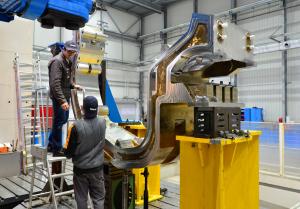"At ITER, we are used to dealing with systems that do not fit in the typical categories of industrial equipment," explains Laurent Ferrand, the ITER Technical Responsible Officer for the cassette bodies Procurement Arrangement. "When you first look at the technical specifications, what you see is a massive, complex stainless steel structure with lots of welds and very stringent welding and inspection requirements. But of course, it's much more than that ..."
Tolerances on the cassette bodies are sub-millimetric, which is quite standard for ITER but a huge challenge for such a massive component with moving parts. Leak-tightness is an even bigger challenge: "The prototypes were leak-tested at dedicated satellite facilities in Cannes, France, and Pisa, Italy. The engineers there were quite impressed by the 'ITER leak-tight' requirements—our criteria for a component like a cassette body are several orders of magnitude tighter than those for a satellite's fuel tank, for example."
Despite these considerable constraints and difficulties, Walter Tosto and CNIM-SIMIC took up the challenge, worked their way faultlessly through the prototyping phase, and produced fully functional components. The (numerous) lessons learned will be of great value for the series manufacturing phase.
Plasma-facing components and auxiliary systems will eventually be attached to the cassette body to form an 8-tonne cassette assembly that will be positioned within tenth-of-millimetre tolerances in order to be perfectly aligned with the machine's magnetic axis.
As minute variances during the manufacturing process and assembly of the vacuum vessel are inevitable, the positioning of the cassette assemblies, and hence of the whole divertor, will need to "recover" these slight departures from nominal dimensions and positions—a feat that will be achieved by custom machining the
rail sections to which the cassette assemblies will be attached as well as all the interfacing elements between the divertor and the vacuum vessel structure.



